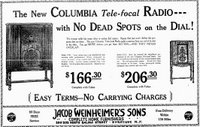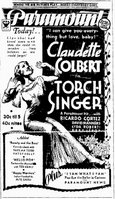
Not long after the birth of recorded sound itself, the same instrument that astonished the world would take on a far more mundane and familiar chore, that of first advertising itself --- and then every other technical innovation it would spawn.
In the following justly famous Edison advertising cylinder from 1906, the phonograph is brilliantly presented not merely as just a way to hear selections from "The Bohemian Girl" after a theatrical presentation has left town, but as an indispensable mechanical device bestowed with almost human qualities, always at the ready to serve you.
"Edison Advertising Cylinder" (1906)
If your home contained dispirited elders, the phonograph was there to draw them from the chimney corner and effectively amuse and quiet them --- while serving a similar purpose for dull infants, raffish youngsters, a fatigued spouse, or those confined to the sick room who always ran the risk of becoming potential candidates for transforming into one of the "loved ones who are far away" mentioned in the machine's recording capability segment.
While unspoken, the selling point here is clearly that of a product that will effectively relieve the owner from restrictive domestic duties, leaving them free to presumably rush out and buy additional cylinders to keep the phonograph fed and running. Or, perhaps to visit... Coney Island?
Although it would take time, recorded sound and Edison's phonograph would cease being a novelty. Instead it became so completely integrated into the movement of daily life that a visitor to Coney Island's Luna Park probably wouldn't be astonished by the raucous sound of a mechanically reproduced voice saying "Thank You" from a concealed speaker as they exited an attraction via a gate or turnstile. While I suppose a typical reaction might be along the "What won't they think of next!" sort, the real purpose of the installation was to create memorable and effective cross promotion for a product or service other than the one just consumed.
The effectiveness of the device isn't known, but I suspect it wouldn't be long before the small cylinders became horribly degraded from constant use, ultimately emitting a garbled squawk that would frighten or annoy rather than persuade. Then too, pity any attendant stationed nearby for hours on end!
The arrival and wide public acceptance of radio as a source of immediately accessible entertainment coincided with the arrival of talking films, and both mediums formed an almost instant union with the objective of one aiding the other, although ultimately it was film that reaped the benefit.
In a convoluted bit of supreme joint effort, the following audio excerpt from 1929 features a radio show ("Brunswick Brevities") that was transcribed onto phonograph discs, promoting radio sets for the home by utilizing a medley of tunes from a selection of then current talking pictures produced by MGM. Everyone was served --- and then some, while the public enjoyed a lovely piece of music to listen to over dinner. Here, a Brunswick Brevities "talkie medley" containing tunes from "The Pagan," "The Broadway Melody," "Marianne" and "The Hollywood Revue."
"Brunswick Brevities" (1929) - Excerpt
The early musicals were a boon to the record and sheet music industries, with all closely aligned corporate hands in a pot being duly filled with coin at every turn, as the public sought to quench its thirst for music from the latest talkies they've seen, or wanted to see --- or somehow managed to miss.
Here, in a promotional disc produced by the Victor Record Company, Richard Barthelmess' film "Weary River" (First National-1929) is used as the peg upon which to hang lures for not one but two different renditions of the film's theme song (by Rudy Vallee and Gene Austin) and also for the film itself.
Victor Promotional Disc for "Weary River" (1929)
In then new concept that would outlive products, songs, films and activities --- and generations of consumers, for that matter, it's still with us today but as an inescapable bludgeon rather than something as genuinely attractive as the closing offering, a transcribed radio promotion for the 1933 Paramount film "Torch Singer," wherein it is supposed Claudette Colbert's singing voice was supplemented with one belonging to vocalist Sylvia Froos. As with most things, the illusion is preferable to the reality. Certainly more mystifying.





1 comment:
Brunswick's parent company (Brunswick-Balke-Collander, or something like that) was bought by Warner Bros. either in late 1929 or early 1930. Allegedly, they needed the record presses to turn out Vitaphone discs. It didn't work out that way, of course, though Brunswick remained a WB-owned record label for some years. Some of the very first Merrie Melodies (ca. 1931) featured Abe Lyman and his Brunswick Recording Orchestra.
So that would have been the end of the cooperation, at least as far as Brunswick Brevities was concerned, with MGM, since MGM and WB were in a cold war as of late 29.
Footnote: B-B-C owned Brunswick sporting goods, the bowling ball and other stuff under that name. Harry Warner admitted that WB (under financial pressure with all its debt) made a mistake in selling off the sporting goods business shortly afterward, which survives to this day.
Post a Comment